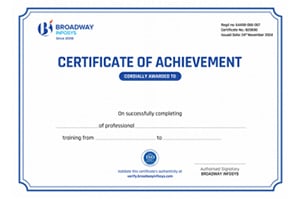
STATA (Software for Statistics and Data Science) is an integrated software package that helps you in your data science needs. If you are in research profession and willing to take STATA Training in Nepal, Broadway is an ideal destination. This course is designed for those students who are in the fields of economics, sociology, and political science. Thus, STATA training will help you grow in your professional life. STATA is affordable, easy to use, learn, and the trainees learn essential skills to use all the feature of data management, graphics, and statistics needed for graphic visualization and modeling of large data sets. Broadway Infosys has excellent instructors and fully equipped training labs to help students pursue the world class STATA training in Nepal.
Our network with several research based organizations and data management focused companies is the key to our students’ placement. Please feel free to connect us via our website, social media or directly visit us. We want to make sure you secure your seats at the earliest for our upcoming STATA training session.
Here are the key benefits of learning STATA:
Joining our internationally recognized STATA training offers the following advantages:

Stata basics
Add this credential to your LinkedIn profile, resume, or CV to stand out to recruiters.
